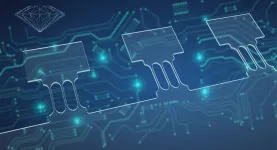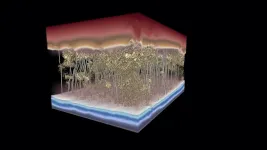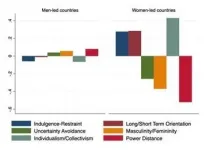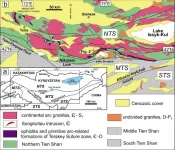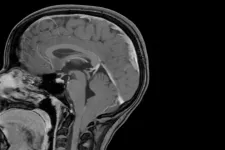(Press-News.org) Diamond is the hardest material in nature. But out of many expectations, it also has great potential as an excellent electronic material. A joint research team led by City University of Hong Kong (CityU) has demonstrated for the first time the large, uniform tensile elastic straining of microfabricated diamond arrays through the nanomechanical approach. Their findings have shown the potential of strained diamonds as prime candidates for advanced functional devices in microelectronics, photonics, and quantum information technologies.
The research was co-led by Dr Lu Yang, Associate Professor in the Department of Mechanical Engineering (MNE) at CityU and researchers from Massachusetts Institute of Technology (MIT) and Harbin Institute of Technology (HIT). Their findings have been recently published in the prestigious scientific journal Science, titled "Achieving large uniform tensile elasticity in microfabricated diamond".
"This is the first time showing the extremely large, uniform elasticity of diamond by tensile experiments. Our findings demonstrate the possibility of developing electronic devices through 'deep elastic strain engineering' of microfabricated diamond structures," said Dr Lu.
Diamond: "Mount Everest" of electronic materials
Well known for its hardness, industrial applications of diamonds are usually cutting, drilling, or grinding. But diamond is also considered as a high-performance electronic and photonic material due to its ultra-high thermal conductivity, exceptional electric charge carrier mobility, high breakdown strength and ultra-wide bandgap. Bandgap is a key property in semi-conductor, and wide bandgap allows operation of high-power or high-frequency devices. "That's why diamond can be considered as 'Mount Everest' of electronic materials, possessing all these excellent properties," Dr Lu said.
However, the large bandgap and tight crystal structure of diamond make it difficult to "dope", a common way to modulate the semi-conductors' electronic properties during production, hence hampering the diamond's industrial application in electronic and optoelectronic devices. A potential alternative is by "strain engineering", that is to apply very large lattice strain, to change the electronic band structure and associated functional properties. But it was considered as "impossible" for diamond due to its extremely high hardness.
Then in 2018, Dr Lu and his collaborators discovered that, surprisingly, nanoscale diamond can be elastically bent with unexpected large local strain. This discovery suggests the change of physical properties in diamond through elastic strain engineering can be possible. Based on this, the latest study showed how this phenomenon can be utilized for developing functional diamond devices.
Uniform tensile straining across the sample
The team firstly microfabricated single-crystalline diamond samples from a solid diamond single crystals. The samples were in bridge-like shape - about one micrometre long and 300 nanometres wide, with both ends wider for gripping (See image: Tensile straining of diamond bridges). The diamond bridges were then uniaxially stretched in a well-controlled manner within an electron microscope. Under cycles of continuous and controllable loading-unloading of quantitative tensile tests, the diamond bridges demonstrated a highly uniform, large elastic deformation of about 7.5% strain across the whole gauge section of the specimen, rather than deforming at a localized area in bending. And they recovered their original shape after unloading.
By further optimizing the sample geometry using the American Society for Testing and Materials (ASTM) standard, they achieved a maximum uniform tensile strain of up to 9.7%, which even surpassed the maximum local value in the 2018 study, and was close to the theoretical elastic limit of diamond. More importantly, to demonstrate the strained diamond device concept, the team also realized elastic straining of microfabricated diamond arrays.
Tuning the bandgap by elastic strains
The team then performed density functional theory (DFT) calculations to estimate the impact of elastic straining from 0 to 12% on the diamond's electronic properties. The simulation results indicated that the bandgap of diamond generally decreased as the tensile strain increased, with the largest bandgap reduction rate down from about 5 eV to 3 eV at around 9% strain along a specific crystalline orientation. The team performed an electron energy-loss spectroscopy analysis on a pre-strained diamond sample and verified this bandgap decreasing trend.
Their calculation results also showed that, interestingly, the bandgap could change from indirect to direct with the tensile strains larger than 9% along another crystalline orientation. Direct bandgap in semi-conductor means an electron can directly emit a photon, allowing many optoelectronic applications with higher efficiency.
These findings are an early step in achieving deep elastic strain engineering of microfabricated diamonds. By nanomechanical approach, the team demonstrated that the diamond's band structure can be changed, and more importantly, these changes can be continuous and reversible, allowing different applications, from micro/nanoelectromechanical systems (MEMS/NEMS), strain-engineered transistors, to novel optoelectronic and quantum technologies. "I believe a new era for diamond is ahead of us," said Dr Lu.
INFORMATION:
Dr Lu, Dr Alice Hu, who is also from MNE at CityU, Professor Li Ju from MIT and Professor Zhu Jiaqi from HIT are the corresponding authors of the paper. The co-first authors are Dang Chaoqun, PhD graduate, and Dr Chou Jyh-Pin, former postdoctoral fellow from MNE at CityU, Dr Dai Bing from HIT, and Chou Chang-Ti from National Chiao Tung University. Dr Fan Rong and Lin Weitong from CityU are also part of the team. Other collaborating researchers are from the Lawrence Berkeley National Laboratory, University of California, Berkeley, and Southern University of Science and Technology.
The research at CityU was funded by the Hong Kong Research Grants Council and the National Natural Science Foundation of China.
DOI number: 10.1126/science.abc4174
https://www.cityu.edu.hk/research/stories/2021/01/01/stretching-diamond-next-generation-microelectronics
AMES, Iowa - Nature has figured out how to make great membranes.
Biological membranes let the right stuff into cells while keeping the wrong stuff out. And, as researchers noted in a paper just published by the journal Science, they are remarkable and ideal for their job.
But they're not necessarily ideal for high-volume, industrial jobs such as pushing saltwater through a membrane to remove salt and make fresh water for drinking, irrigating crops, watering livestock or creating energy.
Can we learn from those high-performing biological membranes? Can we ...
Countries led by women have not fared significantly better in the COVID-19 pandemic than those led by men- it may be just our Western media bias that makes us think they have!
INFORMATION:
Article Title: "Gender in the time of COVID-19: Evaluating national leadership and COVID-19 fatalities"
Funding: The author(s) received no specific funding for this work.
Competing Interests: The authors have declared that no competing interests exist.
Article URL: https://journals.plos.org/plosone/article?id=10.1371/journal.pone.0244531
...
Very low birthweight infants are at a high risk for anemia and often need blood transfusions to survive. Some doctors use a higher level and some use a lower level of red blood cells to order a transfusion. A National Institutes of Health-funded study suggests that providing a higher threshold of red cells within clinically accepted limits (i.e., using a higher level of red blood cells when ordering a transfusion) offers no advantage in survival or reduction in neurological impairment over a lower threshold.
This large, multi-center randomized clinical trial was conducted ...
COLUMBUS, Ohio -- When using social media to nudge people toward safe and healthy behaviors, it's critical to make sure the words match the pictures, according to a new study.
After looking at social media posts, parents of young children were better able to recall safety messages such as how to put a baby safely to sleep when the images in the posts aligned with the messages in the text, the researchers found.
The study appears in the Journal of Health Communication.
"Many times, scientists and safety experts aren't involved in decisions about social media for health agencies and other organizations, and we end up seeing images that have nothing to do with the safety message ...
The scientists from St Petersburg University began to study the geology of Central Asia in the middle of the 20th century. Multi-year research and rich field experience have made it possible to create the world's leading school of thought in the geology of the Tien Shan at the University. At present, work continues with active collaboration with scientists throughout the world.
One of the recent discoveries of the international research team is the discovery of this specific rock assemblage that is characteristic of ...
BOSTON - Reports of possible allergic reactions to the COVID-19 vaccines produced by Pfizer-BioNTech and Moderna, both recently approved for emergency use by the U.S. Food and Drug Administration (FDA), have raised public concern. A team of experts led by allergists at Massachusetts General Hospital (MGH) has now examined all relevant information to offer reassurance that the vaccines can be administered safely even to people with food or medication allergies. The group's review is published in the Journal of Allergy and Clinical Immunology: In Practice.
In response to accounts of potential allergic reactions in some people following COVID-19 ...
People with certain genetic conditions are likely to have significant symptoms of autism, even if they do not meet all diagnostic criteria, a study concludes.
Researchers at Cardiff University say their findings show clinical services need to adapt so that people diagnosed with autism-linked genetic conditions are not denied access to vital support and interventions.
Published in The American Journal of Psychiatry, the international study analysed data from 547 people who had been diagnosed with ...
ADELPHI, Md. -- Multi-domain operations, the Army's future operating concept, requires autonomous agents with learning components to operate alongside the warfighter. New Army research reduces the unpredictability of current training reinforcement learning policies so that they are more practically applicable to physical systems, especially ground robots.
These learning components will permit autonomous agents to reason and adapt to changing battlefield conditions, said Army researcher Dr. Alec Koppel from the U.S. Army Combat Capabilities Development Command, ...
Gallium is a highly useful element that has accompanied the advancement of human civilization throughout the 20th century. Gallium is designated as a technologically critical element, as it is essential for the fabrication of semiconductors and transistors. Notably, gallium nitride and related compounds allowed for the discovery of the blue LED, which was the final key in the development of an energy-efficient and long-lasting white LED lighting system. This discovery has led to the awarding of the 2014 Nobel Prize in Physics. It is estimated that up to 98% of the demand for gallium originates from the semiconductor ...
About one in 100 children has a common brain disorder called Chiari 1 malformation, but most of the time such children grow up normally and no one suspects a problem. But in about one in 10 of those children, the condition causes headaches, neck pain, hearing, vision and balance disturbances, or other neurological symptoms.
In some cases, the disorder may run in families, but scientists have understood little about the genetic alterations that contribute to the condition. In new research, scientists at Washington University School of Medicine in St. Louis have shown that Chiari 1 malformation can be caused by variations ...
